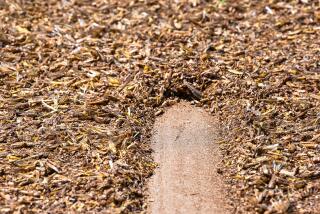The case of the red-shanked grasshopper
- Share via
Two FBI agents and a Bakersfield police officer walked into the Bohart Museum of Entomology at UC Davis four years ago carrying a car radiator and air filter splattered with insects.
I’m the museum director, and they asked me and my entomologist colleagues whether we could tell where the car had been just by examining the dead bugs.
What the lawmen knew, but I wouldn’t learn for some time, was that the car had been rented in Ohio by someone they suspected in a murder. They theorized that the suspect drove to California, killed his family and then drove back to Ohio.
If, as the defendant claimed, he had never left Ohio, there would be no insects on the radiator from outside that region, reasoned one of the FBI agents. They knew the history of the rental car, that the prior drivers had never left Ohio. So if we found any insects from west of the Rockies, that would discredit the suspect’s alibi.
I wasn’t sure if we could answer the lawmen’s question. There are more than 100,000 kinds of insects just in the U.S., and to our knowledge, no one had ever used insect identification to prove where a car had or hadn’t been.
Like any other animal, most insects have distinctive features and specific habitat requirements. Only a few species, like houseflies, occur everywhere. But would the insects from the car be intact enough to identify? Enough to rule out all the others?
We found 30 individual insects, but mostly we just had pieces of them to work with — a couple of wings and part of a body, or a body and head but no legs. But it is quite possible to make identifications from such fragments if you’re practiced at it and have a collection for comparison.
Six insects told the story. Two were beetles that are known to live only in the eastern U.S. But then we found the large back leg of a grasshopper. Its markings revealed it to be a red-shanked grasshopper (Xanthippus corallipes pantherinus), found no farther east than Kansas and central Texas.
On the radiator was the unmistakable large golden paper wasp (Polistes aurifer), minus a few wings and legs. It can live as far east as Kansas, but it is most abundant in California. And then on the air filter we found two true bugs (Neacoryphus rubicollis and Piesma brachiale or ceramicum), their brightly colored, distinctively sculpted bodies largely intact. These species are found only in Arizona, Utah and Southern California.
The rental car must have passed through states west of Colorado, consistent with the idea that the suspect had driven west on either Interstate 70 or 40. (That also explained the 4,500 or so unaccounted-for miles on the odometer.) The insect analysis was entered into evidence, I testified and, on May 15 in the Bakersfield Superior Court, the jury convicted Vincent Brothers of the murder of his wife, three children and mother-in-law.
It seems like case closed. But there is a problem. The U.S. is losing the taxonomy expertise that makes it possible to identify insect bits on a car radiator, or the exotic mosquito hitchhiking in a container of lucky bamboo, or a stealthy caterpillar sheltered inside a flat of strawberries. I’ve been studying, teaching about and identifying insects for 30 years, but there are few specialists in the wings.
We as a culture have become overly enamored with technology. We’ve lost sight of the fact that it is still much cheaper and faster to have a specialist identify an insect by sight than to have a technician analyze its DNA. No DNA has been sequenced for 99% of insect species, so even if you get a usable sample from a car radiator, there’s nothing on file to match it against.
But accurate insect identification can catch any number of killers — human, pathogen or infestation. Insects feed on us, our crops and our livestock. They give us diseases, such as West Nile virus. New pests are coming into California all the time.
Every state needs insect expertise, but most rely on the Systematic Entomology Laboratory in Maryland, part of the research branch of the U.S. Department of Agriculture, or the goodwill of the few research taxonomists working at universities and museums. The FBI has no insect taxonomic expertise at all.
We need a West Coast diagnostics center like the USDA’s, staffed with specialists who can identify insects by sight as well as DNA. UC Davis and the California Department of Food and Agriculture have proposed creating a world-class biodiversity center at the university that could identify not just pests but also medically important insects and beneficial plants and animals. It could also train the next generation of entomologists. But to build it, we need money — government funds and private donations. Both are hard to come by.
In the meantime, we’re lucky to catch the pests that slip into California. Take the case of the light brown apple moth (Epiphyas postvittana), a pest from Australia that feeds on more than 200 fruit trees and other plants. Retired UC Berkeley professor Jerry Powell, a taxonomic specialist, trapped one in his Berkeley backyard March 22. Since then, it has been detected in nine counties. The state is taking urgent measures to determine how far it has spread and to rein it in before it damages millions of dollars’ worth of apples, avocados and other fruit.
From criminal trials to medicine to food protection, insects demand our attention. Insects have stories to tell — but only if someone’s there to listen.


